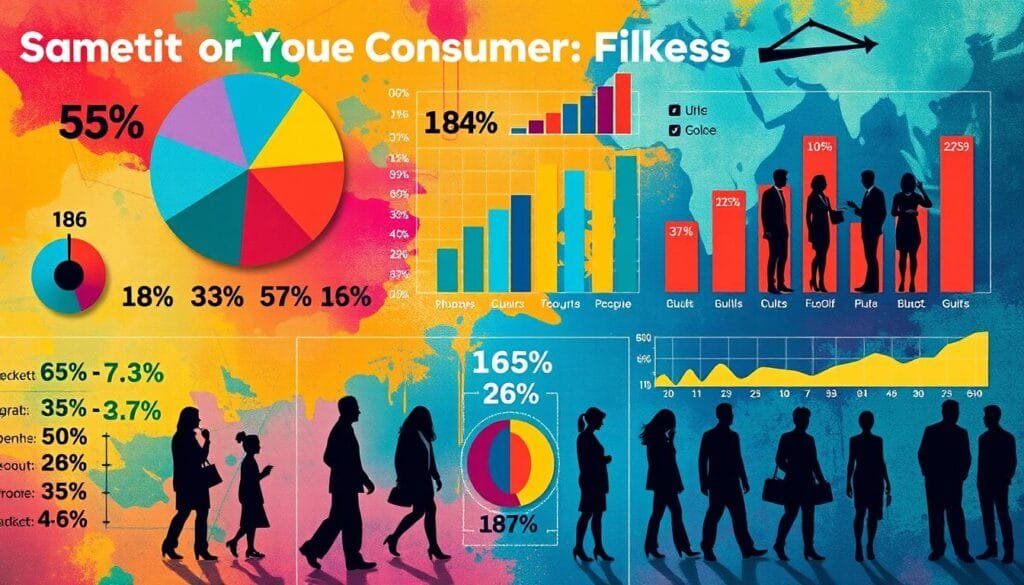Understanding consumer lifestyles is vital for businesses looking to customize their offerings. Knowing what customers want helps companies stay ahead in a fast-paced market. It involves analyzing lifestyle trends and consumer behavior to build loyalty and improve sales strategies.
Consumer lifestyles include activities shaped by culture, tech, media, and personal beliefs. Businesses use demographic and psychographic segmentation to understand these aspects. This allows them to grasp customer needs, spot trends, and notice shifts in behavior.
Today’s world is driven by data, making technology key in studying consumer lifestyles. Tools like data analysis, artificial intelligence, and surveys reveal what consumers prefer. This knowledge helps businesses compete, find market opportunities, and refine their marketing to meet consumer expectations.
Key Takeaways
- Consumer lifestyles are influenced by culture, demographics, technology, media, values, and beliefs.
- Effective measurement involves demographic and psychographic segmentation, such as age, gender, income, and interests.
- Technology, including AI and machine learning, enhances the accuracy of lifestyle measurements.
- Understanding consumer lifestyles helps companies stay competitive and anticipate market trends.
- Surveys and social media analytics are key tools for gaining insights into consumer behavior.
Understanding Consumer Lifestyles
Consumer lifestyles cover a wide range of activities, interests, and buying habits. By studying these elements deeply, companies can grasp how people use their resources. This understanding is key for creating marketing that speaks directly to various groups, improving customer involvement.
Studies show lifestyle aspects alone offer limited insights. Yet, when linked with factors like risk perception, their value jumps. For example, risk perception alone can clarify about 65 percent of differences in consumer actions. This shows how combining lifestyle with other data can deeply unveil consumer patterns.
Consumer behavior studies find mixing demographics and psychographics with lifestyle information very telling. Together, they offer rich details about what drives buyers. Long-term research confirms the major impact of these techniques in marketing and understanding consumer habits.
To clear this up, let’s compare various predictors of consumer behavior:
| Predictor | Variance Explained |
|---|---|
| Physiological Indicators | 0-5% |
| Lifestyles | 0-5% |
| Attitudes, General | 0-5% |
| Knowledge, Information | 0-5% |
| Demographics | 5-10% |
| Personality, Non-Intellectual | 5-10% |
| Intelligence | 10-20% |
| Risk Perception | 10-20% |
| Attitudes, Specific | around 50% |
| Intentions, Specific | over 50% |
Lifestyle segmentation is crucial for finding loyal, profitable customers. It helps in crafting customized marketing strategies. This segmentation stands out in competitive markets. Also, it builds deeper emotional bonds with clients and drives innovation in new products.
For 50 years, the concept of “lifestyles” has been a big focus in market study and segmentation, proving its worth in understanding buyer behaviors and shaping marketing approaches.
Key Metrics to Measure Consumer Lifestyles
Examining consumer lifestyles means looking at key areas to understand how people behave. We look at demographic analysis, psychographic profiling, and consumer engagement metrics to get this insight. Knowing these metrics helps companies to meet their audience’s needs better.
Demographics
At the core of understanding consumer lifestyles is demographic analysis. Age, gender, income, and education level are critical:
- Age: Different age groups, like Gen Z or Baby Boomers, have their own spending habits.
- Gender: Men and women make buying decisions based on different priorities.
- Income Level: More money often means buying luxury items and preferring top brands.
- Education Level: Well-educated consumers might seek out more informational products.

Psychographics
Going deeper, psychographic profiling looks at what drives a consumer’s choices, including their lifestyle and values:
- Lifestyle Choices: A person’s lifestyle, like being active or tech-savvy, influences what they buy.
- Values and Beliefs: What people care about, such as sustainability, affects their brand choices.
- Personality Traits: Things like being willing to take risks or loyal to brands guide consumer behavior.
Behavioral Metrics
We then measure how people interact with brands through behavioral metrics. This includes:
- Purchase Frequency: This tells us how often people buy, showing if they like the product or are loyal to the brand.
- Brand Loyalty: This checks if consumers keep coming back to the same brand, showing their satisfaction.
- Engagement Levels: This looks at how much people interact with a brand’s messages and online content.
Trends and Influences
By looking at trends and what influences consumers, companies can adjust their strategies:
- Cultural Shifts: Things like global events and social media can change what consumers want.
- Technological Advances: New tech, such as shopping apps, change how people shop and interact with brands.
- Behavioral Tracking: Using data from websites and apps, brands can understand consumer habits better.
In summary, using demographic analysis, psychographic profiling, and consumer engagement metrics gives businesses a deep look at consumer lifestyles. This understanding helps them to make their marketing more effective.
How to Measure Consumer Behavior Effectively
Understanding consumer behavior is key for great marketing strategies. By using things like surveys and analyzing sales data, companies can understand what people like and do. This helps them see the full picture of consumer preferences and actions.
Utilizing Surveys and Focus Groups
Consumer surveys are great for getting feedback straight from people. They reach over 335M+ people across more than 130 countries. This helps in understanding different consumer groups well. Focus groups go deeper into what people think and like. This is especially useful for big decisions like buying a car or a house.
Leveraging Social Media Analytics
Social media analysis can uncover what consumers like and their buying motives. Trends on these platforms reflect cultural impacts on buying. For example, influencers or viral trends play a big role, particularly with Millennials. They make up 20% of the online buyers in America.
Monitoring Sales Data
Tracking sales shows buying habits and trends. By looking at sales data, companies understand what items are bought over and over. This helps see why some prefer known brands, to lessen the fear of making a bad choice. E-commerce growth means even small companies are up against the big ones. This makes sales analysis even more crucial.
Incorporating Behavioral Tracking
Behavioral data, like from website cookies or apps, tracks what consumers do online. It’s key for spotting those looking for something new. Personalizing based on this data can double returns, since tailored experiences make consumers more loyal and likely to buy again.
| Buying Behavior Type | Characteristics | Influencing Factors |
|---|---|---|
| Complex Buying Behavior | High involvement, significant brand differences | Psychological, Economic |
| Habitual Buying Behavior | Routine, low thought or effort | Cultural, Personal |
| Variety-Seeking Buying Behavior | Frequent brand switching | Social, Cultural |
| Dissonance-Reducing Buying Behavior | High involvement, few brand differences | Psychological, Social |
How Are Consumer Lifestyles Be Measured
Today, understanding consumer lifestyles is key in the data-driven market. We use many innovative methods and analysis techniques for this. Knowing consumer preferences and the changing aspects of their behavior is vital. We do this by bringing together different data points.

We now measure facial expressions to learn about food likes and habits. Also, eye tracking technology helps see how people shop. It shows what influences buying choices in malls and stores.
Using ultra-wideband tags, we can follow customer movements in stores. This offers valuable info on how supermarkets affect buying decisions. It shows the impact of the shopping environment on choices. It proves why we need to test preferences in realistic settings.
Neuromarketing is also gaining popularity. It looks at brain activity, facial expressions, and bodily reactions to understand buying decisions better. This approach teaches us more about how consumers decide, helping businesses keep up with trends.
The group called Professional Aunt, No Kids (PANKs) has a big social and economic role. There are 18.4 million PANKs between 20-50 years in the US. This is over a quarter of all American women in this age range. Knowing what they prefer and do is great for marketers. Notably, 74% have college degrees, many have master’s degrees, and almost half own homes.
PANKs spend a lot, about $61 billion a year, on kids in their life. They mainly spend on travel, food, drinks, and fun. Their role is clear as 63% help with a niece’s or nephew’s schooling. They play a big part in children’s lives, whether as “Aunts by Relations” (93%) or “Aunts by Choice” (57%).
Adding these findings to traditional research like surveys and tracking technology gives a full picture of consumer lifestyles. Accurate measuring consumer preferences and using different lifestyle analysis techniques show true consumer behavior.
Common Mistakes to Avoid
Getting lifestyle measurements right depends on good data, understanding trends, and knowing your audience. Let’s go over three mistakes to dodge and how to do it.
Neglecting Data Quality
Neglecting data quality is a big mistake. Good data is crucial. Using old or wrong data can lead you in the wrong direction. It affects how relevant and competitive you are.
Did you know 56% of online surveys are done on mobiles? This means surveys should work well on all devices to keep data quality high. Kantar’s research found that better surveys can get responses that reflect the wider population. This shows how vital good data collection methods are.
Ignoring Trends
Another mistake is ignoring trends. Analyzing trends shows how consumer behavior changes. If you miss these trends, your marketing won’t hit the mark.
As discussed here, keeping up with the market is key for long-term success. Creating surveys that consider mobile usage gets deeper insights. This helps adjust strategies in time.
Focusing Solely on Demographics
Relying only on demographics isn’t enough. You also need to look at psychographics and how people behave. Adding info about emotions, social aspects, and behaviors gives a fuller picture.
Surveys longer than 12 minutes often lose people’s interest. And if surveys don’t include diverse groups, they can be biased. This limits what we can learn from the data.

Running surveys right means paying attention to quality, trends, and a broad view of consumers. Using comprehensive reports, businesses can better understand customers. They can mix demographic, psychographic, and behavior data for better decisions.
| Common Mistake | Impact | Solution |
|---|---|---|
| Neglecting Data Quality | Misleading business decisions | Optimize data collection and enhance survey design |
| Ignoring Trends | Outdated marketing strategies | Stay updated with market trends |
| Focusing Solely on Demographics | Incomplete consumer insights | Integrate psychographic and behavioral metrics |
Best Practices for Analyzing Consumer Data
To understand consumer behavior, we need a detailed approach. This includes finding the best ways to analyze data and figuring out what customers are thinking. By looking at the data carefully, we can find valuable info. This helps us make our marketing better, improve our products, and make customers happier.
Start by looking at important info like who your customers are. This means analyzing things like their age, gender, how much money they make, their education, and where they live. Age distribution, gender ratios, income levels, education background, and geographic location are key. Then, look into their lifestyle, what they value, and how they see themselves. This gives deeper insights.
It’s also key to check out how people behave. This means seeing how they find brands, how often they buy, how much they spend, and their favorite ways to shop. For example, 32% of internet users will talk about brands they like online if they feel a connection. Also, it’s vital to understand how they feel about brands, including their loyalty and quality perception.
Using new tech in analyzing data is crucial. Tools like machine learning and AI help spot trends and guess what might happen next. This makes our understanding of consumers stronger. Checking the data regularly helps our strategies stay up-to-date with what people want and expect.
- Ethical Use of Data: Being clear and asking for permission when gathering data.
- Utilize Advanced Analytics: Use machine learning and AI to get deep insights.
- Iterative Data Review: Keep looking at your data and tweaking your approach.
Following these steps not only makes our study of consumer behavior more precise but also helps businesses adapt to changing markets. For instance, when brands use social media info wisely, they often see a boost in sales.
| Source | Brand Discovery (%) | Effectivity |
|---|---|---|
| TV Ads | 31% | High |
| Pre-roll Ads | 17% | Medium |
| Social Media Ads | Increasing | High |
In the end, the best way to look at consumer data is to be ethical and use the latest tech. As customer behaviors change, it’s key to be flexible and well-informed. This helps keep and grow brand loyalty and sales.
Conclusion
Understanding consumer lifestyles is key in strategic consumer analysis. It helps us know what people like and how they spend. By looking at consumer habits and who they are, we get vital info. Using lifestyle segments and knowing what consumers think help us make better marketing plans.
We can learn a lot by using surveys on what people like and studies on why they buy things. Keeping up with consumer behavior is a must in our fast-changing world. We have to stay ahead, adapt quickly, and make messages that not only catch attention but also earn loyalty.
Looking ahead to 2023, focusing on experiences is more crucial than ever for staying top in the market. Knowing how consumers live their lives helps companies stand out. Let’s use what we’ve learned to improve how we track consumer habits. This will make sure our businesses grow with the changing needs of our customers.
FAQ
What is consumer lifestyle measurement?
Consumer lifestyle measurement looks at how people live, what they like, and what they buy. It shows businesses how to make products that fit people’s lives better. This way, companies can serve their customers in the best way possible.
Why is understanding consumer lifestyles important for businesses?
Knowing what consumers want helps businesses predict trends and keep customers happy. It enables them to create products that really speak to people’s needs. This sharpens their marketing and boosts customer connections.
What are the key metrics used to measure consumer lifestyles?
Businesses look at things like demographics, lifestyle, behavior, and what’s trending. Each aspect gives a different view of what customers want. Together, they form a clear picture.
How do demographics inform consumer segments?
Details about people’s lives, like age and income, help businesses spot who might like their products. This info is key to targeted ads and offerings.
What are psychographics and why are they important?
Psychographics dive deep into what makes people tick – their values and personalities. They let businesses tailor their approach, making messages that truly resonate.
How can businesses assess behavioral metrics?
Companies look at how often people buy, their loyalty, and how they interact with brands. These clues help shape future strategies.
How do trends and influences impact consumer behavior?
Changes in culture and tech can shift what people want. Keeping an eye on these trends helps companies stay ahead and relevant.
What techniques can be used to measure consumer behavior effectively?
Methods like surveys, social media tracking, and looking at sales figures give insights into what people think and want. Each tool helps in its own way.
How do surveys and focus groups help in measuring consumer behavior?
They collect people’s opinions and likes directly. This feedback is gold for creating or tweaking products.
What role do social media analytics play in consumer behavior analysis?
Social media gives a peek into what’s trending and how people feel about different topics. It’s key for understanding customer attitudes.
Why is monitoring sales data important for consumer analysis?
Sales trends show what’s hot and what’s not. This info guides businesses in making what sells best.
What is behavioral tracking and how is it used?
Tracking online behavior with cookies or apps spots what catches people’s attention. It’s crucial for fine-tuning online experiences.
What are some common mistakes to avoid in consumer lifestyle measurement?
Skipping out on data quality, not following trends, and just looking at demographics are pitfalls. Mixing in rich insights and trends gives a fuller view.
How can we ensure data integrity in consumer analysis?
Strong data habits and constant updates keep the info fresh and reliable. This makes the consumer picture clear and accurate.
Why is it important to integrate psychographics and behavioral insights with demographics?
Blending detailed personal insights with basic stats paints a full picture. It helps companies make marketing that truly speaks to people.
What are the best practices for analyzing consumer data?
Use data wisely and keep up with analytics advances. Always tweak strategies to meet people’s current needs. Staying updated is key.
